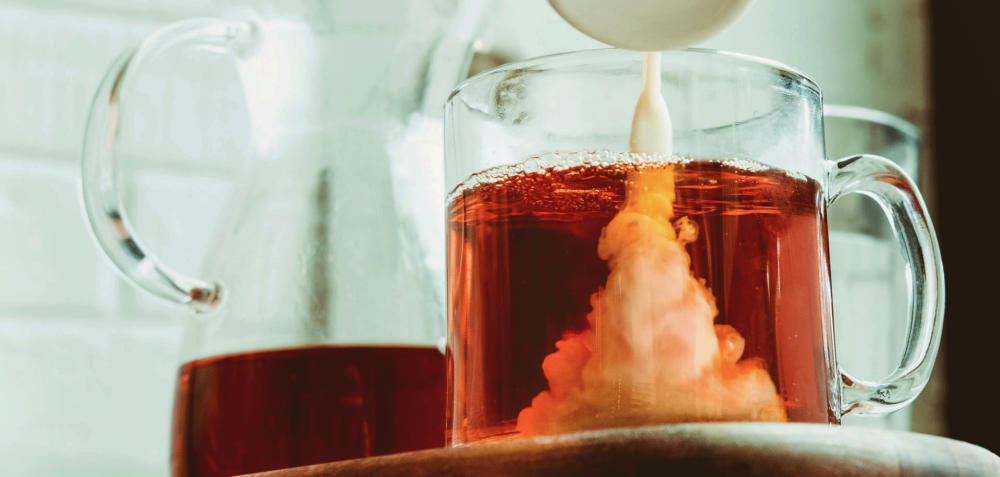Table of Contents
Introduction
Milk tea, a globally cherished beverage, transcends cultural boundaries with its diverse interpretations and flavors. Originating from ancient tea traditions, this creamy concoction has evolved into a beloved beverage, embraced by tea enthusiasts and casual sippers alike. Join us on a journey to explore the origins, types, recipes, and cultural significance of milk tea—a delightful fusion where the richness of tea meets the velvety embrace of milk. Discover the artistry behind this comforting elixir and the myriad ways it has been adapted across cultures.
Origins of Milk Tea
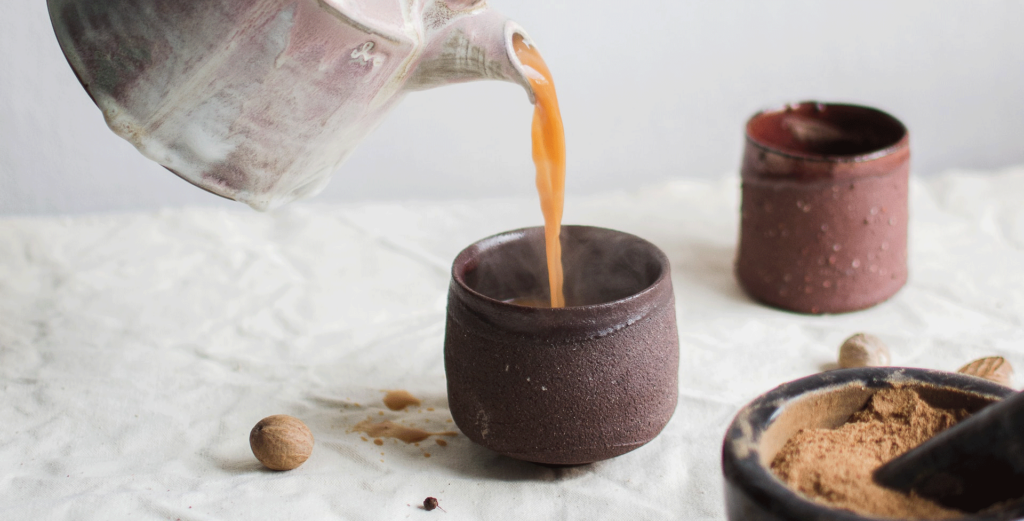
Milk tea, a beloved beverage enjoyed globally, has a rich and diverse history rooted in various cultures. The origins of milk tea can be traced back to traditional tea-drinking practices that evolved over centuries. Let’s trace together the fascinating journey of milk tea.
Chai in India
Ancient Ayurvedic Origins:
- Holistic Healing Brews: Chai’s story begins in ancient India, where Ayurveda, the a holistic system of medicine that emphasizes balance and harmony within the body. Tea, known for its energizing qualities, became a canvas for incorporating various Ayurvedic elements.
- Balancing Elements: Ayurvedic principles emphasize balancing the doshas (Ayurvedic philosophy categorizes individuals into three doshas—Vata (air), Pitta (fire), and Kapha (earth). Balancing these doshas is central to well-being) in the body. Chai became a vehicle for delivering these balancing elements. For example, ginger brings warmth, cardamom aids digestion, cinnamon adds sweetness, and cloves contribute to respiratory health.
The Evolution of Chai
- Tea as a Carrier: The medicinal properties of tea leaves were recognized in Ayurveda for their ability to invigorate and provide a sense of alertness.
- Integration of Spices: To enhance both flavor and therapeutic benefits, Ayurvedic practitioners began infusing teas with various spices.
Key Spices and Their Ayurvedic Properties
- Cardamom (Elaichi): Known for its ability to balance all three doshas, cardamom adds a touch of sweetness while aiding digestion.
- Cinnamon (Dalchini): Offers warmth, improves circulation, and brings a sweet note to chai. It is particularly beneficial for balancing Kapha.
- Ginger (Adrak): With its warming properties, ginger helps pacify Vata and Kapha imbalances, promoting digestion.
- Cloves (Laung): Adds a spicy kick and is believed to enhance circulation and reduce inflammation.
Chai as a Balancing Elixir
- Vata Imbalance: For individuals with a dominant Vata(air) dosha, chai’s warmth helps ground and stabilize, counteracting the airy qualities of Vata.
- Pitta Pacification: The cooling effect of certain spices in chai aids in balancing Pitta(fire), preventing an excess of heat in the body.
- Kapha Regulation: Spices like ginger and cloves impart warmth, countering Kapha’s (earth) cold and damp tendencies.
Brewing Rituals
- Communal Alchemy: Chai transcends a mere beverage; it’s an alchemical process, often prepared in large pots to foster a communal experience. Simmering black tea leaves or bags with an array of spices in water and milk creates a robust infusion, allowing flavors to meld over an extended period.
- Chai Wallah Craftsmanship: Street vendors, the chai wallahs, are artisans in their own right. Pouring and repouring the tea from one vessel to another, they create a frothy, well-mixed brew that tantalizes the taste buds.
Cultural Integration
- Symbol of Hospitality: Offering chai is a symbol of hospitality and warmth in Indian culture. Guests are often welcomed with a cup of chai, fostering connection and conversation.
- Street Corner Conversations: Chai serves as a catalyst for social interactions, with vibrant discussions unfolding at street corners and tea stalls.
- Adaptations Worldwide: Chai has transcended borders, with various adaptations worldwide. Masala chai, a spiced milk tea, has become a beloved global beverage.
The traditional origins of milk tea showcase a fascinating interplay of cultural practices, culinary traditions, and historical influences. Whether sipped from a masala chai cup in India or savored in a Hong Kong teahouse, milk tea’s journey reflects the diversity and depth of global tea culture.
Hong Kong Milk Tea: A Cultural Brew
Historical Roots
- British Influence: Hong Kong’s love affair with tea traces back to its colonial past. The British introduced the concept of afternoon tea, and locals embraced the ritual with their own twists.
- Adaptation of Milk Tea: The classic Hong Kong Milk Tea is an adaptation of traditional British black tea with milk, but it has evolved into a distinct and cherished local specialty.
Tea Leaves Selection
- Blend of Teas: Hong Kong Milk Tea often uses a blend of strong, robust black teas. Ceylon, Assam, and sometimes Lapsang Souchong contribute to the bold flavor profile.
- Fine Tea Strainers: The use of cloth sieves or “pantyhose tea socks” is a distinctive feature, filtering the tea leaves for a smoother texture.
Brewing Technique
- Double Brewing: Hong Kong Milk Tea involves a unique double-brewing process. The tea is first brewed to create a concentrated “stock” that is then combined with hot water or milk for a second brewing.
- Tea-Pulling Technique: The iconic “tea-pulling” method involves pouring the tea mixture between two containers to aerate and blend the flavors. This technique is both artful and functional.
Sweetened Condensed Milk
- Key Sweetener: What sets Hong Kong Milk Tea apart is the use of sweetened condensed milk as a sweetener. This adds a rich, creamy sweetness to the robust tea base.
- Ratio Matters: Achieving the perfect balance between the strong tea and the sweetened condensed milk is an art form. Skilled tea makers are adept at finding the ideal ratio.
Cultural Significance
- Cha Chaan Teng Culture: Hong Kong Milk Tea is an integral part of the local “cha chaan teng” (tea restaurant) culture. These casual eateries serve as hubs for socializing and enjoying comfort food, with Milk Tea being a star attraction.
- Morning Tradition: It is a common sight to see locals starting their day with a cup of Hong Kong Milk Tea, often paired with a crispy pineapple bun or other local delights.
Evolution and Innovation
- Variations: While the classic recipe remains a staple, creative variations have emerged. Some tea houses offer options like iced milk tea, yuanyang (a mix of coffee and tea), or flavored milk teas.
- Modern Twists: Contemporary cafes and tea houses often experiment with ingredients like matcha or herbal infusions to add a modern twist to this traditional beverage.
Iconic Status
- Symbol of Identity: Hong Kong Milk Tea has become more than just a drink; it symbolizes the unique blend of East and West in Hong Kong’s cultural identity.
- Recognized Worldwide: Its popularity has transcended borders, earning recognition as a must-try beverage for visitors and a nostalgic taste for the Hong Kong diaspora.
Hong Kong Milk Tea is not just a beverage; it’s a cultural icon that encapsulates the history, flavors, and communal spirit of Hong Kong. The meticulous brewing process and the blend of tradition with innovation make it a truly distinctive and cherished tea experience.
Evolution and Globalization
Spread Across Asia:
- As international trade flourished, tea and its diverse preparations, including milk tea, spread across Asia.
- Each region added its own twist, incorporating local ingredients and flavors, resulting in a myriad of milk tea variations.
Global Popularity:
- In the 20th century, the globalization of cuisines and the rise of multiculturalism contributed to the worldwide popularity of milk tea.
- Asian diasporas played a crucial role in introducing milk tea to new corners of the globe, from London to New York.
Contemporary Adaptations:
- The 21st century witnessed a surge in creativity, leading to contemporary adaptations like bubble milk tea (boba tea), matcha milk tea, and other innovative blends.
- Social media platforms further fueled the global obsession with aesthetically pleasing and delicious milk tea concoctions.
Cultural Fusion
Cultural Exchange:
- Milk tea exemplifies the beautiful fusion of cultural traditions, illustrating how culinary practices can transcend borders.
- The exchange of ideas and ingredients has resulted in a diverse array of milk tea styles, each with its own unique charm.
Symbolism and Rituals:
- In many cultures, the act of sharing milk tea is laden with symbolism, representing hospitality, community, and the blending of diverse elements.
- Milk tea has become an integral part of social rituals, from casual gatherings to formal ceremonies.
The origins of milk tea showcase a tapestry of cultural influences and historical encounters. From the bustling streets of Mumbai to the tea houses of Hong Kong, the journey of milk tea is a testament to the enduring appeal of this delightful beverage.
Types of Milk Tea: A Symphony of Flavors
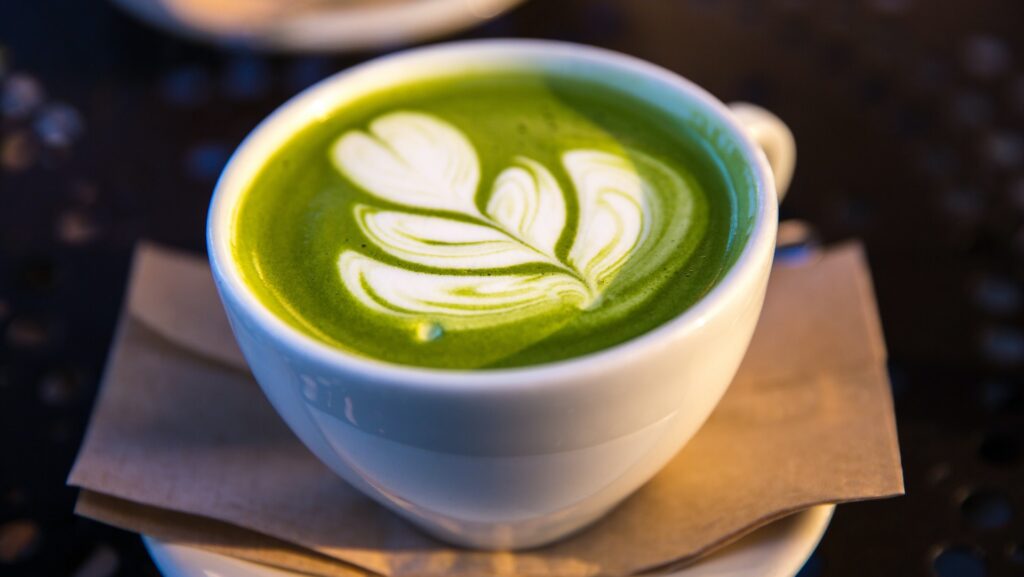
1. Classic Milk Tea
- Ingredients: A timeless blend of robust black tea and rich, velvety milk.
- Sweetness Level: Typically sweetened with sugar or condensed milk.
- Serving Styles: Enjoy it hot or iced, with regional variations like Thai or Hong Kong-style.
2. Masala Chai
- Ingredients: Black tea infused with a melange of aromatic spices – cardamom, cinnamon, ginger, and cloves.
- Preparation: Brewed with milk, often sweetened for a harmonious blend.
- Cultural Roots: Originating from India, masala chai is an integral part of Indian chai culture.
3. Bubble Tea (Boba Tea)
- Base Tea: Diverse tea bases such as black, green, or oolong tea.
- Signature Element: Chewy tapioca pearls for a delightful textural experience.
- Variety: Available in a spectrum of flavors, and can be enjoyed with or without milk.
4. Matcha Latte
- Base Tea: Finely ground Japanese matcha green tea.
- Preparation: Whisked with milk to create a vibrant and frothy beverage.
- Health Twist: Renowned for its antioxidants and striking green hue.
5. Thai Iced Tea
- Base Tea: Strongly brewed Ceylon or Assam tea.
- Additions: Sweetened condensed milk and evaporated milk.
- Flavor Profile: A harmonious blend of sweetness and spice, often served over ice.
6. Teh Tarik
- Origin: Malaysia and Singapore.
- Pulling Technique: “Teh Tarik” translates to “pulled tea” – a mesmerizing pouring technique.
- Sweetened Elegance: Typically sweetened with condensed milk.
7. Yakult Iced Tea
- Ingredients: Black tea combined with Yakult, a probiotic dairy beverage.
- Taste Profile: Balancing tea bitterness with the sweetness and tartness of Yakult.
- Refreshing Twist: A popular choice for those seeking a refreshing and probiotic-rich drink.
8. Hojicha Latte
- Base Tea: Japanese roasted green tea (hojicha).
- Distinctive Flavor: Known for its toasty and nutty notes.
- Milk Harmony: Blended with milk for a comforting and flavorful latte.
9. Oolong Milk Tea
- Base Tea: Semi-oxidized oolong tea leaves.
- Flavor Complexity: A nuanced profile, balancing the characteristics of black and green teas.
- Versatility: Can be served sweetened or unsweetened, hot or cold.
10. Chai Latte
- Ingredients: A spiced concoction featuring black tea, spices, and steamed milk.
- Spice Symphony: Infused with cinnamon, cardamom, ginger, and cloves.
- Indulgent Treat: A comforting and aromatic choice, perfect for chai enthusiasts.
11. Herbal Infusions
- Base Ingredients: Various herbal teas like chamomile, peppermint, or lavender.
- Dairy-Free Option: Often enjoyed without milk or with plant-based alternatives.
- Calming Effects: Herbal infusions offer a soothing and caffeine-free experience.
The world of milk tea unfolds like a symphony of flavors, each type playing a distinct note in the grand composition of tea culture. Whether you’re drawn to the robust warmth of masala chai or the playful chewiness of boba tea, there’s a milk tea variety to suit every mood and preference. Explore, savor, and immerse yourself in the delightful universe of milk teas from around the globe!
Milk Tea Ingredients: Crafting Harmony in Every Sip
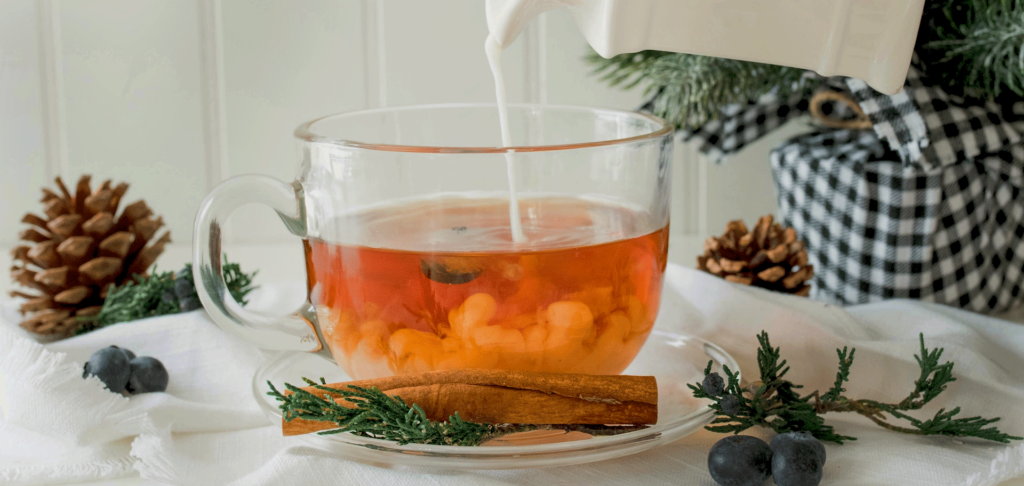
Tea Leaves:
- Varieties: The choice of tea leaves determines the base flavor of the milk tea. Common options include black tea (Assam, Ceylon), green tea, oolong tea, and herbal teas.
- Blend Possibilities: Tea blends, like Earl Grey or chai spices, add unique dimensions to the beverage.
Milk:
- Classic Choice: Cow’s milk is the traditional and widely used option, providing a creamy and smooth texture.
- Variations: Non-dairy alternatives such as almond milk, soy milk, coconut milk, or oat milk cater to various dietary preferences.
Sweeteners:
- Sugar: Commonly used to sweeten milk tea. The amount can be adjusted based on personal taste preferences.
- Condensed Milk: Offers a rich sweetness and is a signature component in drinks like Hong Kong-style milk tea.
- Honey or Syrups: Natural sweeteners that add depth and complexity to the flavor.
Spices and Flavorings:
- Masala Chai Spices: For masala chai, spices like cardamom, cinnamon, ginger, and cloves create a warm and aromatic blend.
- Vanilla or Almond Extract: Enhances the flavor profile, providing a subtle and fragrant note.
Tapioca Pearls (Boba):
- Base for Bubble Tea: Chewy tapioca pearls, often added to bubble tea, contribute a delightful textural element.
- Flavor Options: Tapioca pearls may also be infused with flavors like honey or brown sugar.
Sweetened Condensed Milk (SCM):
- Signature Element: Particularly featured in Thai and Vietnamese iced teas, SCM adds a sweet and creamy consistency.
- Versatile Usage: Used in various milk tea recipes and desserts.
Ice:
- Temperature Balance: Ice is crucial for iced milk teas, providing a refreshing contrast to the warmth of the brewed tea and milk.
- Ice Varieties: Regular ice cubes, crushed ice, or even flavored ice cubes can be used.
Yakult (Probiotic Beverage):
- Health Twist: Added to some milk teas for a probiotic boost and a slightly tangy flavor.
- Pairing: Often paired with green or oolong teas.
Evaporated Milk:
- Rich Texture: Known for its thicker consistency, evaporated milk contributes a creamy and indulgent quality to the tea.
Hojicha Powder (for Hojicha Latte):
- Base for Hojicha Latte: Ground hojicha tea leaves create a unique and toasty flavor profile.
- Caffeine Level: Hojicha offers a lower caffeine content compared to traditional tea varieties.
Chai Concentrate:
- Convenience: Pre-made chai concentrate simplifies the preparation of chai lattes, ensuring a consistent and robust flavor.
Matcha Powder (for Matcha Latte):
- Base for Matcha Latte: Finely ground matcha green tea imparts a vibrant color and earthy flavor to the tea.
- Health Benefits: Known for its antioxidant properties.
Herbal Infusions:
- Chamomile, Lavender, or Peppermint: Offer a caffeine-free alternative with distinct herbal notes.
- Calming Qualities: Herbal infusions are often chosen for their soothing properties.
The art of crafting the perfect cup of milk tea lies in the thoughtful combination of these ingredients. Whether you prefer the boldness of masala chai or the playful textures of bubble tea, each component plays a crucial role in creating a harmonious and delightful beverage. Experiment with different elements to discover your ideal blend and savor the myriad flavors of milk tea!
Classic Milk Tea Recipe: A Symphony of Flavors
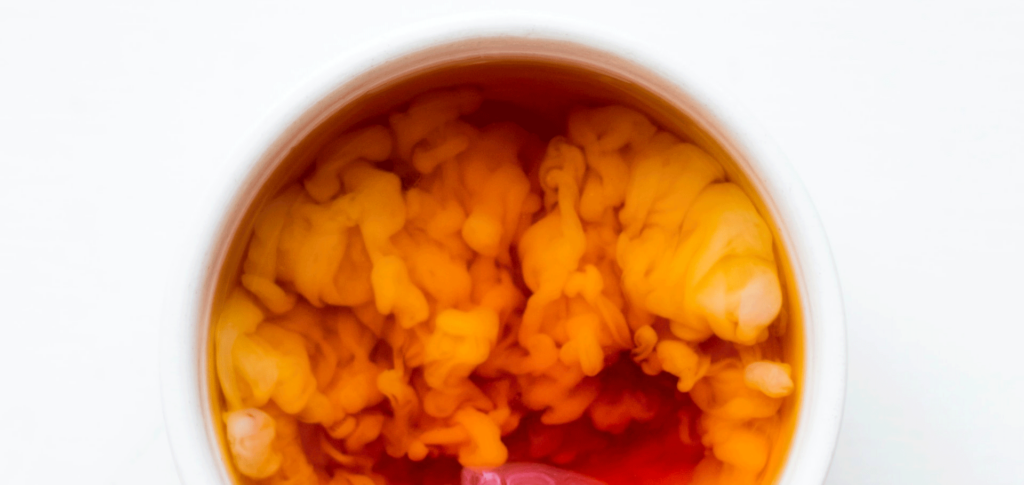
Ingredients:
- 2 teaspoons of loose-leaf black tea (Assam or Ceylon)
- 1 cup of water
- 1/2 cup of milk (whole milk or your preferred alternative)
- 2 teaspoons of sugar (adjust to taste)
- Optional: Condensed milk for added sweetness
Instructions:
- Boil Water:
- Bring one cup of water to a rolling boil. If you’re using a kettle, allow it to whistle or bring water to a vigorous boil on the stovetop.
- Brew the Tea:
- Place the loose-leaf black tea in a teapot or a tea infuser within your cup.
- Pour the boiling water over the tea leaves.
- Let the tea steep for 3 to 5 minutes, depending on your desired strength. Adjust steeping time to achieve the preferred boldness.
- Strain the Tea:
- Remove the tea leaves or infuser to prevent over-brewing. This step ensures the tea doesn’t become bitter.
- Add Sweetener:
- Stir in sugar to sweeten the tea. Start with 2 teaspoons and adjust according to your taste preference.
- For an extra sweet and creamy option, add a teaspoon of condensed milk. Stir until the sugar and condensed milk dissolve.
- Heat Milk:
- In a separate pot or using a milk frother, heat the milk until it’s warm but not boiling. This step is crucial for achieving the perfect temperature and texture.
- Combine Tea and Milk:
- Pour the brewed tea into a cup.
- Slowly add the warmed milk, stirring gently to blend the flavors.
- Optional: Froth the Milk:
- For a frothy finish, use a milk frother or simply pour the milk back and forth between two containers to create a layer of foam.
- Serve and Enjoy:
- Your classic milk tea is ready to be savored! Take a moment to appreciate the aroma before indulging in the rich and comforting flavors.
Tips:
- Experiment with different tea varieties or blends to discover your preferred base flavor.
- Adjust the sugar and milk ratios based on your sweetness and creaminess preferences.
- Feel free to incorporate spices like cardamom or cinnamon for a chai-inspired twist.
- For iced milk tea, allow the brewed tea to cool before adding ice and cold milk.
This classic milk tea recipe serves as a canvas for creativity. Whether you enjoy it hot or iced, sweetened or spiced, the beauty of milk tea lies in its adaptability to suit individual tastes. Happy brewing!
Cultural Significance of Milk Tea: A Global Journey
Milk Tea in Various Cultures:
Milk tea, in its diverse forms, holds a special place in the hearts and cups of people around the world. Each culture has embraced this comforting beverage, infusing it with unique flavors and traditions. In India, the masala chai blends robust tea with a medley of spices, while Hong Kong’s silk stocking milk tea stands out for its velvety texture. The British elevate teatime with classic English breakfast tea and milk, creating a cultural ritual steeped in tradition.
Social and Cultural Practices:
The act of sharing a cup of milk tea transcends mere consumption; it becomes a social ritual. In Asian cultures, tea houses and street vendors offer bustling hubs for socializing over cups of freshly brewed tea. The British afternoon tea tradition is an elegant affair, fostering social connections over delicate china cups. Milk tea is not just a beverage; it’s a catalyst for conversations, bonding, and shared moments.
Symbolism and Traditions:
Milk tea often carries symbolic significance, reflecting cultural values and traditions. In some cultures, it symbolizes hospitality, welcoming guests with a warm cup. In others, it serves as a symbol of unity, bringing people together to celebrate shared experiences. The act of preparing and serving milk tea can be a cultural expression, passing down recipes and rituals from one generation to the next.
Milk tea’s cultural significance extends beyond its ingredients; it embodies the stories, customs, and connections of diverse communities. Whether sipped in a bustling market, enjoyed during a serene teatime, or savored in a cozy corner, milk tea is more than a beverage—it’s a vessel carrying the richness of cultural heritage and shared moments. As we raise our cups, we partake in a global tapestry woven with the threads of tradition, community, and the timeless joy of sharing a sip of comfort.
Health Considerations in Milk Tea
Caffeine Content:
Milk tea, depending on its base tea type, contains varying levels of caffeine. While black tea-based milk teas offer a moderate caffeine kick, green tea variants may provide a milder boost. For those mindful of their caffeine intake, herbal blends or decaffeinated teas can be delightful alternatives without compromising flavor.
Nutritional Aspects:
Milk tea’s nutritional profile is influenced by its components. The addition of milk contributes to calcium and protein content, while the tea base may provide antioxidants. However, sweeteners and flavored syrups can introduce added sugars. It’s essential to strike a balance, opting for natural sweeteners or adjusting sugar levels to align with personal dietary goals.
Moderation and Alternatives:
Enjoying milk tea in moderation is key to a balanced lifestyle. For those watching their sugar intake, exploring sugar-free or low-calorie sweeteners can be a prudent choice. Additionally, herbal infusions, such as chamomile or peppermint, can be crafted into delightful milk-free teas for those seeking alternatives.
As with any beverage, considering individual health needs and preferences is crucial when relishing the pleasures of milk tea. Whether embracing the antioxidant-rich qualities of green tea or opting for caffeine-free herbal blends, the world of milk tea offers a diverse array of options for a beverage experience that aligns with your well-being goals. Balancing indulgence with conscious choices ensures that every sip contributes not only to flavor satisfaction but also to a holistic approach to health and wellness.
Conclusion
As we conclude our exploration of the rich tapestry of milk tea, it’s evident that this beloved beverage is more than just a drink—it’s a cultural emblem, a comforting ritual, and a canvas for creative flavor expressions. From the bustling streets of Hong Kong to the serene tea houses in Taiwan, milk tea’s journey is as diverse as the people who relish its flavors. So, whether you find solace in a classic chai, embrace the modernity of bubble tea, or concoct your own signature blend, let each sip be a celebration of the global symphony that is milk tea. May your cups be filled with warmth, indulgence, and the joy of a shared cultural experience.

